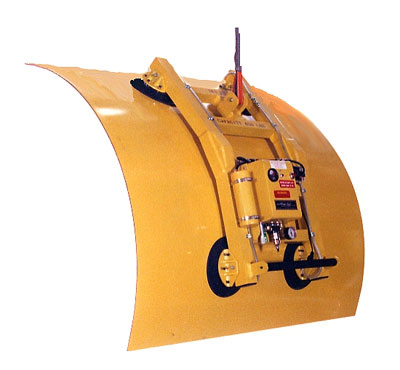
One of the frequent questions we get here at Wood’s Powr-Grip is, “Can I lift curved glass with any of your products?”
One of the frequent questions we get here at Wood’s Powr-Grip is, “Can I lift curved glass with any of your products?” You may be surprised to learn the answer is, “Yes.” Vacuum lifters can be specifically designed with a wide range of vacuum cups and lifters that can attach to curved or bent surfaces.
 |
|
| Custom pads enable vacuum lifters to handle just about any size and shape. Vaccum lifters enable glass handling with less physical wear and tear and less chance of dropping expensive product.
|
Lifting curved or bent materials presents unique challenges. Most standard vacuum pads are nearly flat and designed to attach quickly and easily on flat surfaces. In contrast, vacuum pads designed for curved surfaces have unique characteristics that make them suitable for attaching to such surfaces. These vacuum pads have a concave shape and a thinner edge profile, to facilitate contact with a curved surface. Also, concave vacuum pads are usually manufactured with a lower durometer rubber that enables the pad to conform to the curved surface, requiring less pressure against the surface to establish an unbroken seal. A third feature, employed on our newest vacuum pads for curved materials, is a rounded sealing edge. Since the shape of some load surfaces can change during a lift, this design allows the sealing edge to roll and shift, in order to maintain the seal as the load flexes. Special vacuum pads make lifting curved materials possible
The degree of curvature (or arc) to which a particular vacuum pad can attach is reflected in its Minimal Material Curvature Radius (MMCR). The MMCR of the concave pad, multiplied by two, reflects the smallest diameter of a sphere to which the pad would readily attach. Since the edges are flexible, the vacuum pad can also attach to cylinders or other curved shapes. For example, if you need to lift a tube with a diameter of 24 inches and weighing 80 pounds, a vacuum pad with an MMCR of 12 inches or less would be required.
When it comes to lifting large, curved materials, such as windows, building facades, auto body parts, curved stone or nonporous columns weighing hundreds of pounds, it is time to bring in the big guns.
Swap pads to repurpose
Standard vacuum lifters are often used to manipulate materials with curved surfaces. Standard vacuum pads can be replaced with concave pads designed for curved surfaces and used on these multipurpose lifters. For vacuum lifters that feature multiple frame configurations, a linear configuration often is most suitable for attaching to curved materials.
While simply adding concave vacuum pads on a standard vacuum lifter may work in many circumstances, some applications may require special options. Pad mounting options such as spring-shaft pad mounts and rotating pad mounts can be incorporated, along with concave vacuum pads, for less radical situations. However, for materials with a large arc, a custom lifter may be necessary.
Custom vacuum lifters with specially shaped pad frames can be designed for nearly any concave or convex curve. The designs range from simple to complex and are available with manual or powered load movements. Some designs incorporate adjustable frame curvature to accommodate a variety of material radiuses, and most are available with either AC or DC power systems.
Get some good advice
Since load capacities may be affected by alterations to your existing vacuum lifter, and the shape of the load, we strongly suggest that you first discuss your requirements with a knowledgeable technical sales representative. They will assist you in obtaining the proper vacuum lifter for your specific curved materials handling needs.
Joe Landsverk is the marketing director of Wood’s Powr-Grip.With more than 20 years service, he oversees and co-ordinates the company’s day-to-day marketing and advertising activities.
Print this page
Leave a Reply